

Yokosuka Ohka - $$6.25
It was a manned flying bomb that was usually carried underneath bombers to within range of its target; on release, the pilot would first glide toward the target and when close enough he would fire the Ohka's rocket engine and guide the missile towards the ship that he intended to destroy. (FYI, 'Ohka' translates to Cherry Blossom)
Yokosuka MXY7 Ohka [Oka] Japanese Flying Bomb
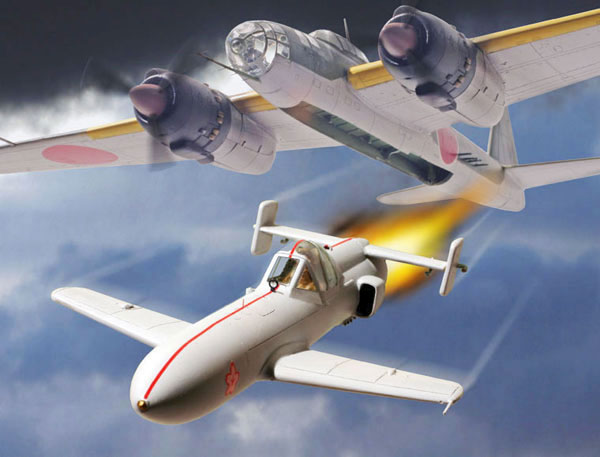
In 1944 a lowly ranked Japanese transport pilot proposed the idea of a rocket-powered aircraft for suicide missions against Allied naval forces. In record rime, the Yokosuka MXY7 Ohka ('Cherry Blossom') was developed and accepted for service.
Carried aloft by G4M 'Betty' bombers, the Ohkas remained attached until 21 miles off the target, well within range of the carrier group's combat air patrols. On their combat debut, all 16 carrier aircraft were shot down before launching their Ohkas. Of the 750 or so Ohkas built, the vast majority were never launched, being shot down while attached to their carrier aircraft or destroyed or captured on the ground. It is thought that they sank about 15 Allied ships, having minimal effect on the Allied advance on Japan.
The Ohka was to have been mass-produced in underground factories, but the war ended before these were completed, one projected version of the rocket bomb, the Ohka 43A,was intended to be catapulted from surface submarines and was to have had folding wings for stowage in deck hangars. The Ohka 43B was basically similar but was designed for the defense of the Japanese homeland and was to have been launched against an invasion fleet from catapults installed in caves. Neither version was built.
The Oka Suicide Flying Bomb
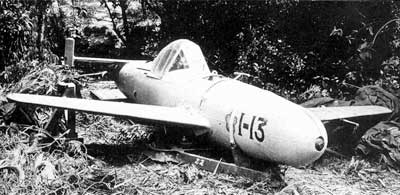 In the course of the Pacific War, the Japanese lost practically all of its warships and aircraft. They also lost two key commanders, Admiral Yamamoto and his successor Admiral Koga.
In the course of the Pacific War, the Japanese lost practically all of its warships and aircraft. They also lost two key commanders, Admiral Yamamoto and his successor Admiral Koga.
In late 1943, proposals were made by Japanese Naval Fighter Pilots for special suicide attacks against the United States Naval Forces to stem the might that was falling upon them. These men were concerned over the inferiority of Japanese Naval and Army strength and they had started to consider suicidal-crash dive tactics with their aircraft to counter growing United States Military strength.
Naval Ensign Ohta, the designer of the OKA bomb, was one of these men. Their idea was originally refused but as the war grew worse for Japan, support grew for Kamikaze Operations.
Captain Jyo, Commander of the Japanese Aircraft carrier "Chiyoda," stated after the Battle of the Philippine Sea in June 1944, "No longer can we hope to sink the numerically I superior enemy carriers through ordinary attack methods. I urge the use of special attack units to crash dive their aircraft and I ask to be placed in command of them."
The "Chiyoda" was later sunk and so the honor to command the Special Attack Group (Kamikaze Corps) fell upon Admiral Takijiro Ohnishi. In October 1944, he took command of the Japanese First Air Fleet in the Philippines. The first organized Kamikaze operations began with volunteers from the 201st Japanese Naval Air Group. This unit was based at Clark Field, 50 miles north of Manila, Philippine Is. The first attacks were made with conventional Zero Fighter Aircraft with 500 Kilogram bombs attached below the aircraft. When the special suicide attacks began in the Philippine Islands, there was for Okinawa another sort of Kamikaze aircraft whose origin lay in events of the preceding year.
Many of the Japanese Admirals on the General Staff did not believe the time for such extreme tactics for Kamikaze was at hand. When the Marianas Islands fell, one after the other and each defeat became increasingly worse for Japan, Kamikaze attack plans were put into effect as the only solution.
During the summer of 1944, a Japanese Naval Officer Ensign Mitsuo Ota was given permission to draw up plans for a special Kamikaze attack aircraft. Ensign Ota was a Naval Aircraft Transport pilot with little engineering background, however, he applied for and received assistance from the aviation research department of Tokyo University. When the drawings were completed, they were submitted to Yokosuku Naval Depot for approval. The Navy Command approved Ota's design in late 19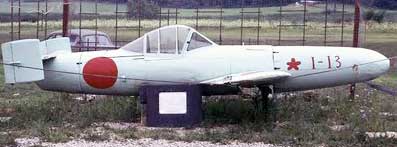 44 and this aircraft was afterward named "OKA" which is "Cherry Blossom" in Japanese.
44 and this aircraft was afterward named "OKA" which is "Cherry Blossom" in Japanese.
The OKA was kept very secret, even within high naval circles. Japanese Captain Motoharu Okamura was given command to train the elite pilots of the "OKA Bomb." His attack base was located at Kamiike Air Base just northeast of Tokyo.
The OKA Bomb was a small wooden and metal constructed aircraft. It had room pilot and the nose warhead contained 2645 pounds of explosives. The OKA was usually carried under the belly of a twin engine "Betty" Bomber, although other types of twin engine Japanese bombers could be used with modifications. It was attached and partially hung in the bomb bay by one mounting lug and slings fastened under the wing and empennage.
The OKA was generally launched 25-50 miles from target. lt's range was determined by the altitude at which it could be released. As air-to-air fighting progressed, two additional rocket motors were fitted, one under each wing, to enable the OKA to pull away from prowling Navy Hellcat Fighters. These rocket units could be fixed singly or simultaneously at the Kamikaze pilot's discretion. The OKA had a conventional pilot stick and rudder bar arrangement.
The pilot had at his disposal a selector switch for firing the propulsion rocket charges pull type arming handle for the nose bomb base fuse, a compass, an altimeter, airspeed indicator, rocket temp. gauge and an inclinometer. All control surfaces were dynamically balanced to eliminate flutter at the high speeds the OKA operated. The nose warhead had five fuses, one in the nose and four in the base. The nose fuse was straight impact fuse and was vane armed. Two of the base fuses were straight impact and the other two were of the "all way" type. All four of the base fuses were armed manually by the pilots from the cockpit.'
A post and ring sight was mounted on the OKA for aiding the pilot in aiming the OKA at its target. There is no landing 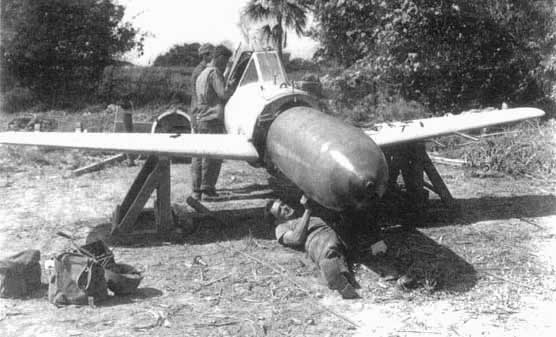 gear and the OKA was moved on a special dolly when on the ground. It had a wing span of sixteen feet and five inches and a length of twenty feet. Its loaded weight was 4,718 pounds. It had three Type 4, MK 1, Model 20 solid fuel rocket motors mounted in the tail. The prototype OKA Bomb was completed in September 1944. Flight testing began on October 23, 1944, using a number of OKAs constructed at the Yokosuka Naval Air Depot. The first prototype was a pilot less OKA 11. It was launched from a Mitsubishi G4M "Betty" Bomber, high above Sagami Bay near Tokyo, at an altitude of 13,000 feet. The test trials were successfully completed and production was increased by adding two additional plants into producing the OKA bomb: Fuji Hikok and Chigasaki-seisakusho.
gear and the OKA was moved on a special dolly when on the ground. It had a wing span of sixteen feet and five inches and a length of twenty feet. Its loaded weight was 4,718 pounds. It had three Type 4, MK 1, Model 20 solid fuel rocket motors mounted in the tail. The prototype OKA Bomb was completed in September 1944. Flight testing began on October 23, 1944, using a number of OKAs constructed at the Yokosuka Naval Air Depot. The first prototype was a pilot less OKA 11. It was launched from a Mitsubishi G4M "Betty" Bomber, high above Sagami Bay near Tokyo, at an altitude of 13,000 feet. The test trials were successfully completed and production was increased by adding two additional plants into producing the OKA bomb: Fuji Hikok and Chigasaki-seisakusho.
The OKA MXY-7 was built as a Training Glider for pilot training. lt differed from the armed OKA 11 primarily in having no rocket powered motor or warhead. A large skid was fitted beneath the fuselage and a smaller one beneath each wing for landing. In order to simulate combat load conditions of the OKA 11, water ballast tanks were fitted at the front and rear of the cockpit. For landing the water was discharged, thereby reducing the weight considerably.
The testing of the prototype OKA MXY-7 Training Glider was carried out by a Japanese Naval Man-Pilot Officer Nagoro at Hykurigaharu Air Base. On October 31, 1944, after the test was completed, he reported the flight handling characteristics were very good. Later the water ballast tanks were deleted as being unnecessary. A total of forty-five OKA MXY-7's were built. One example can be seen today in the Air Force Museum at Dayton, Ohio; however, the skid has been removed to make it appear as an OKA 11.
The OKA pilot would ride in the mother bomber until the target area was approached. He would then climb through the bomb bay of the mother plane into the cockpit of the OKA.
When the enemy position had been made known to the pilot, he would then signal his readiness to the bomber crew. He would pull the release handle and would be on his way in his missile of destruction. Once the release handle was pulled it became a one-way trip for the pilot. American propaganda during the war stated that the Japanese pilots were locked in their cockpit. This was not true. The pilot would glide the OKA toward the remaining distance to the target area, whereupon after selecting the target would ignite all three rocket motors and crash dive into the target at over 600 miles per hour. Needless to say it was very hard to down this aircraft once the Kamikaze aircraft was in the air under its own power.
When the OKA bomb became known it was labeled as the "BAKA BOMB" or "Fool Bomb" and this name prevails to this day
.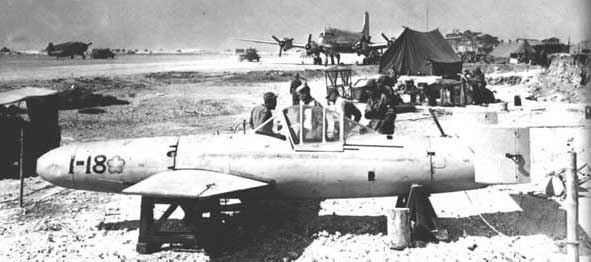
It took a little over six months to train a pilot for the OKA Special Attack Mission. These men were carefully selected from throughout the Navy Air Force and all were well qualified.
With the invasion of Okinawa, Japan knew the crushing might of the United States Navy had to be stopped. Fifty OKA 11's were selected to meet this challenge and on the first day of the Okinawa Invasion, four United States carriers were hit and damaged. The U.S.S. Enterprise, Yorktown, Intrepid, and Franklin by OKA Suicide Flying Bombs.
On March 21, 1945, United States carriers were again sighted just south of Kyushu. Japanese Admiral Ugaki, 5th Air Fleet Commander, took this opportunity for using OKA 11's from Kanoya Air Base.
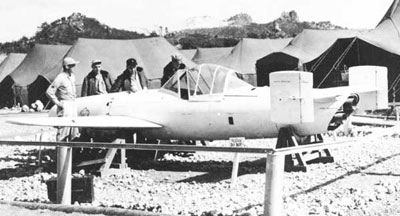 Fighter aircraft protection was assigned but it was felt more fighter aircraft would be needed to protect the slow and vulnerable G4M "Betty" Bomber mother aircraft. The Japanese Navy was well aware of the capabilities of the U.S. Navy's very fine Grumman F6F "Hellcat" fighters.
Fighter aircraft protection was assigned but it was felt more fighter aircraft would be needed to protect the slow and vulnerable G4M "Betty" Bomber mother aircraft. The Japanese Navy was well aware of the capabilities of the U.S. Navy's very fine Grumman F6F "Hellcat" fighters.
The special attack group consisted of sixteen OKA and eighteen mother planes. The flight leader was Naval Commander Goro Naraka. One of the Kamikaze pilots remarked on this sortie: "We are sixteen warriors manning our aircraft. May our death be as sudden as the shattering of crystal." Only thirty Japanese fighters were available to provide fighter escort protection and with this news, the chance for success in this mission became doubtful. The attack was launched regardless and at 4 p.m. at a point sixty miles short of the sighted U.S. fleet, fifty Grumman FGF "Hellcats" attacked the OKA bomber force and destroyed the entire group before the deadly OKA bombs could be released.
In November 1944, the world's largest aircraft carrier at the time, the gigantic Shinano, left Yokosuka Bay during the darkness of night to transport fifty OKA bombs to the philippine islands. But, as it got under way it was spotted and tracked by a U.S. Naval Submarine and sunk on November 29, 1944, off the Japanese mainland. Thus, the projected use of the OKA in the Philippines was precluded.
Special OKA groups of the 721st and 722nd squadrons were based at Kanoya, Miyazaki, Oita, Atsuki and Kamatsu Air Base. The chief targets for the OKA special attack group lay chiefly at Okinawa and the surrounding waters. Early Kamikaze pilots were replaced by new ones, who in turn were replaced by still newer pilots. Some Cherry Blossoms had fallen but there were still more to come.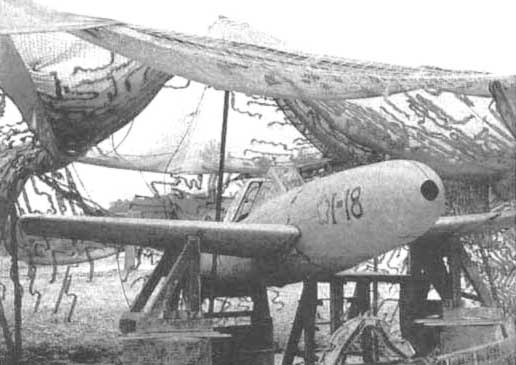
The initial landings on Okinawa were met with little enemy opposition, but the fighting became fierce as U. S. forces went to the interior of the island One of the big surprises to U. S. Technical Air Intelligence men was the capture of six new Japanese OKA." Bombs in caves near Kadena Airfield. These OKA bombs came as a complete surprise to U. S. forces. These special attack aircraft had only arrived from Japan a few weeks before the invasion. They were assembled and were ready for use when U. S. Naval fighters hit the airfield and destroyed their mother aircraft.
The Kamikaze Special Attack Corps derived their name after the typhoon which frustrated the Mongolian invasion of Japan in 1280.
The man who was given responsibility for the formation of the Kamikaze Corps was Vice Admiral Ohnishi. The success of his organization is attributable to the bond of feeling and purpose which existed between he and his men. The watchword of the Kamikaze was "We die for the great cause of our country." The pilots did not consider they were committing suicide but rather were only doing their job as pilots by inflicting the greatest possible damage upon the enemy.
To the Kamikaze pilot, their greatest concern seemed always to have been to make sure that they would hit the target. By comparison, their death to them was a matter of very minor importance. This can be summed up as-There is an old Japanese proverb: "Life is as the weight of a feather compared to one's duty."
The Kamikaze attacks shocked the world primarily because of their certain death-self destruction aspects. The Kamikaze inflicted more casualties to the U.S. Fleet off the Okinawa shore than did the bloody hand-to-hand fighting to the invading troops in the long battle ashore.
The Kamikaze attacks also did tremendous damage to U.S. ships but it failed to produce the desired results which the Japanese hoped for.
It is perhaps hard for the Western mind to accept this idea - a man determined to die in order that he might destroy us in battle.
One of the earliest lessons one learns in battle is that courage is a very common human quality. Evidence of this can be seen from U. S. Navy Torpedo Squadron B at the Battle of Midway in June 1942, where all aircraft and pilots were lost save one pilot.
But there was a fundamental difference in the heroism of Japanese and U. S. flyers. The Japanese resolutely closed all avenues of hope and escape; the American never did. To the Western mind there must always be that last slim chance of survival, that, though a lot of other men may die, you yourself, somehow, someway, will make it back.
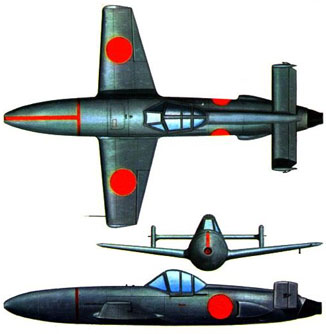
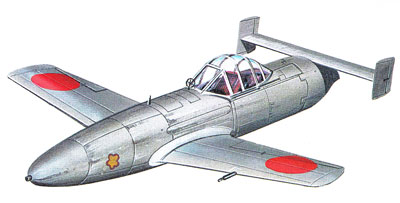 The Yokosuka MXY7 Ohka was a great idea as far as rocket planes went. The Japanese built 755 of them by March 1945, and they were all built from non-strategic materials and were incredibly easy to fly. The pilot was to glide them then punch the rockets for a high speed approach to the target. There is no data on the landing characteristics of the Ohka (cherry blossom), for the ones that reached their targets exploded on impact. They were suicide planes, carrying 2,646 pounds of high explosives in
the nose.
The Yokosuka MXY7 Ohka was a great idea as far as rocket planes went. The Japanese built 755 of them by March 1945, and they were all built from non-strategic materials and were incredibly easy to fly. The pilot was to glide them then punch the rockets for a high speed approach to the target. There is no data on the landing characteristics of the Ohka (cherry blossom), for the ones that reached their targets exploded on impact. They were suicide planes, carrying 2,646 pounds of high explosives in
the nose.
Few actually reached the ships they were intended to hit, however; the launch vehicle, 16 Mitsubishi G4M2e twin-engine Bettys, tended to be destroyed by U.S. fighters before nearing the targets. They still released the Ohka, which usually nosed into the ocean. One did make it to a ship: the destroyer USS Mannert L. Abele, which sunk as a result of a direct hit in April 1945. By then production had ceased on the suicide plane; the Japanese deemed the converted bomber too slow to near the targets.
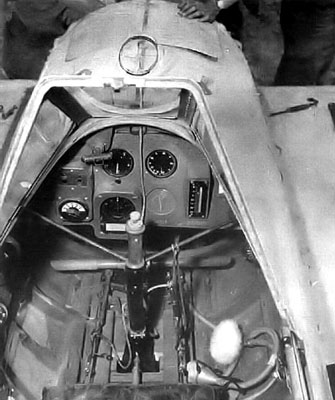 |
| Cockpit of the Yokosuka MXY7 Ohka. |
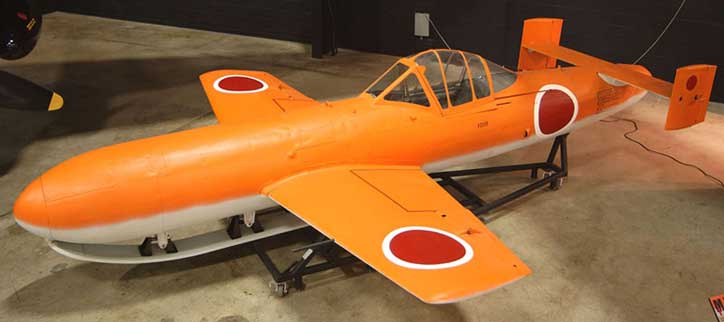 |
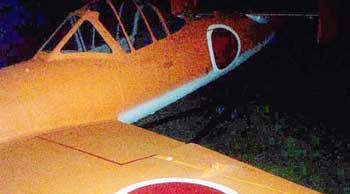 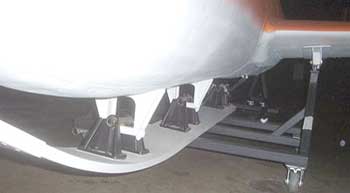 |
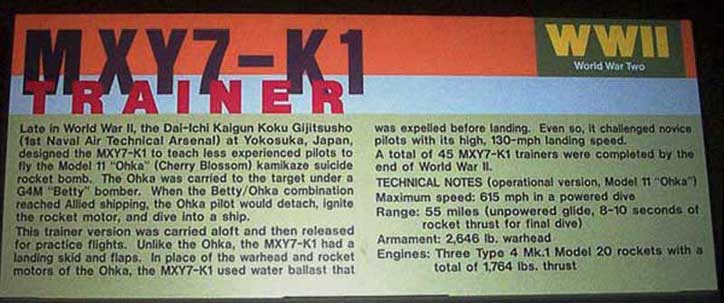 |
These images are were taken at Smithsonian Air and Space Museum. |
Specifications
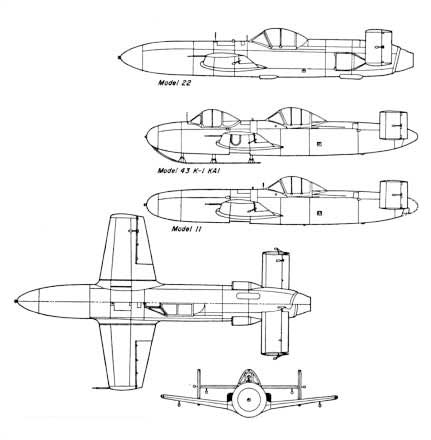 |
Length: 20 ft |
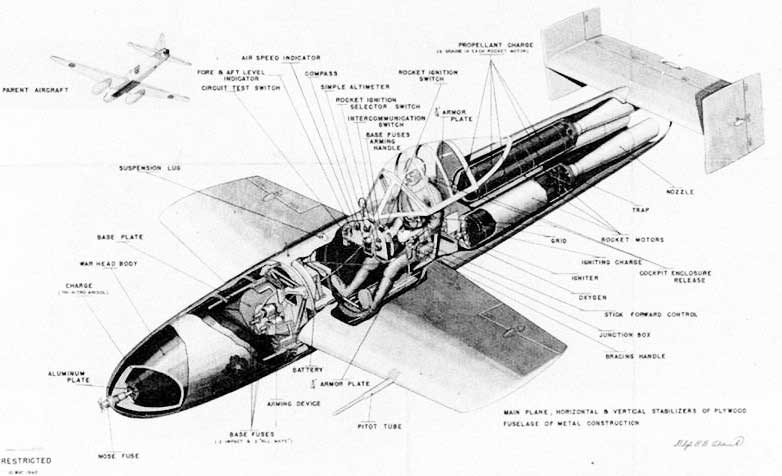
 |
||
| A: The Ohka 11 was armed with a 2645 lb high-explosive warhead in the nose Later versions had smaller warheads. | B: The fuselage was a standard aluminum structure, but the wings were made of molded plywood covered in fabric. | C: Cockpit instrumentation consisted of only four instruments a compass, an airspeed indicator, an altimeter and an inclinometer for turn indication. |
| D: The later Model 22 had a turbojet engine with a small auxiliary piston engine acting as a gas generator. The only test flight of the Model 22 ended in an (unintentional) crash. | E: Would-be suicide pilots were trained to kill themselves in a training glider version, an example of which is preserved in the US Air Force Museum. | F: Known disparagingly by the Allies as the Baka (Fool), the MXY7 was on of the few aircraft actually designed to kill its pilot. Judged against this requirement, it could be considered a success. |
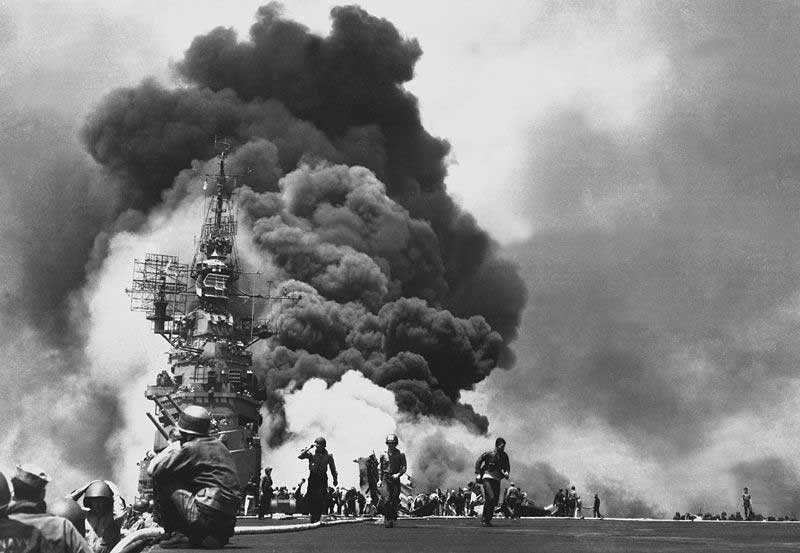
U.S.S. Bunker Hill suffering the attack of an Yokosuka MXY-7 Ohka.


